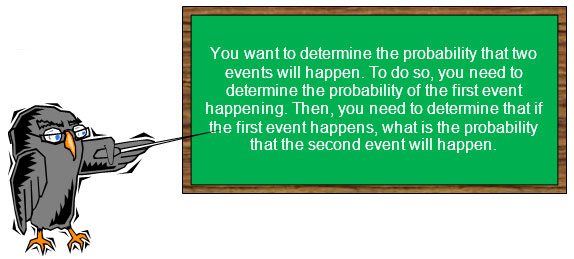
In the last section, you used fractions to write the probability of a simple event. In this section, you will extend that concept to determining the probability of a sequence of independent events occurring.

![]() A bag contains 2 red tiles, 6 green tiles, 1 blue tile, and 3 yellow tiles. Match each simple event with the probability that the event will occur. Drag the probability to the box next to the simple event.
A bag contains 2 red tiles, 6 green tiles, 1 blue tile, and 3 yellow tiles. Match each simple event with the probability that the event will occur. Drag the probability to the box next to the simple event.

Suppose you want to determine the probability that Jeremy will randomly draw a blue tile, replace the tile, and then draw a yellow tile. Use a Venn diagram to represent the relationship between these two events.
![]() Click View Animation to see how the two events are related.
Click View Animation to see how the two events are related.
What operation would you use to find the probability of an event in the intersection of this Venn Diagram?

Use what you have seen so far to answer the following questions.
Interactive popup. Assistance may be required.
Probability is the ratio of the number of ways that Jeremy could draw a blue tile to the number of tiles that Jeremy could draw.
Interactive popup. Assistance may be required.
Probability is the ratio of the number of ways that Jeremy could draw a yellow tile to the number of tiles that Jeremy could draw.
Interactive popup. Assistance may be required.
The probability of both events occurring is the product of the probabilities that each event will occur.
Interactive popup. Assistance may be required.
The probability of both events occurring is the product of the probabilities that each event will occur.

What is the probability that Bradley will draw a vowel, replace the tile, and then draw another tile with a vowel?
Interactive popup. Assistance may be required.
These two events, drawing a green marble and drawing a yellow marble, are independent events because Xuan is replacing the first marble. Determine the probability of each event happening, and then find the product of the probabilities.

Interactive popup. Assistance may be required.
These two events, selecting a prime number and then selecting a number greater than 7, are independent events because repetition of a number is allowed. Determine the probability of each event happening, and then find the product of the probabilities.
